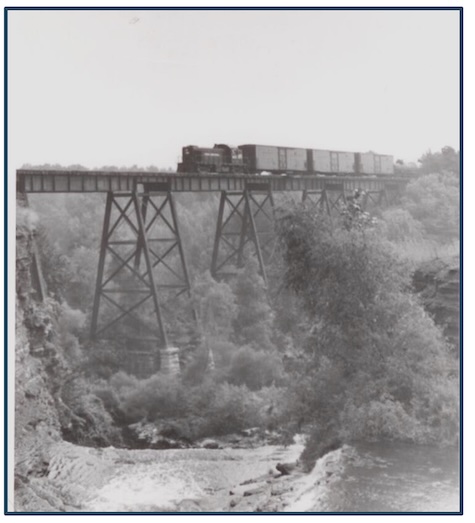Hojack Line cut across northern Orleans, with 8 stations in the county
Rail line was popular leading to post offices, hamlets and businesses
By Catherine Cooper, Orleans County Historian
“Illuminating Orleans” – Volume 5, No. 31

Photo from Orleans County Department of History: A Hojack goods train crosses the Trestle Bridge over the Oak Orchard Creek in Carlton.
KENDALL – “Without looking out a window, you could generally tell what the weather was or what it was going to be simply by the sounds of the Hojack’s whistles. On clear days, they’d be sharp and abrupt. But on rainy days, they’d give out long, mournful cries, especially at night.” (Doris Behnke Crego, Requiem for a Railroad)
In the 1980s, William Aeberli of Rochester, interviewed older Kendall area residents about their recollections of the Hojack and compiled them in a series of articles entitled “Requiem for a Railroad.”
“The Hojack” was the name used to refer to the Rome, Watertown and Ogdensburg Railroad (R.W. & O. R.) which ran from Oswego to Niagara Falls from 1876 to 1978.
It served the northern third of Orleans County where industrious farmers of English, German and Norwegian descent harvested high yields from soil that was particularly suited to fruit cultivation. Prior to the advent of the Hojack, the Erie Canal and later the New York Central Railroad shipped produce from the farms north of the Ridge.
The Hojack served eight station points in Orleans County: Morton (East Kendall), Kendall, West Kendall, Brice Station (Kent), Carlton Station, Ashwood (Carlyon), Lyndonville and Millers.
Hamlets soon evolved at these stations. Storage and processing facilities for fruit and vegetables were built adjacent to the stops: Kendall Cold Storage; Morton Canning Company; A.S. Hice in Ashwood; W.G. Dailey in Kent; Bahrenburg & Beckwith in Carlton Station and Kendall. General stores and churches soon followed. Since the Hojack carried mail, post offices were established: Carlyon in 1876, Carlton in 1877, Kent in 1899, Millers in 1882 and Morton in 1894.
In 1888, eight passenger trains ran daily. By 1908, this was reduced to four daily passenger trains, and in 1933, passenger and mail service was discontinued. Automobiles and truck transportation superseded the railroads. But apart from the convenience of passenger service, the primary benefit of the Hojack was the transportation of goods – fruit and produce to market, deliveries of coal and ice to supply the cold storage facilities.
The Kendall Station was active. The following establishments were located on either side of the railroad: Bahrenburg and Beckwith’s was a cooperage and a storage facility; the Greece Lumber Company which also dealt in grain; the three-story structure at W.V. Newcomb’s which had bins to hold grain, beans, or peas; Robert Burke’s which sold chemicals and fertilizers as well as coal; Carr, Eggleston & Ritz, an evaporated fruit and cider business.
Seasonal laborers and transient workers camped in Crandall’s Woods just across the railroad tracks. The location was referred to as “Hobo Alley.” An old boxcar was moved there to provide shelter.
Doris Behnke Creg, who grew up in Kendall in the 1920s, observed:
“We figured the Hojack was simply a natural part of the neighborhood, we took the railroad for granted. Who might have thought that someday the railroad would disappear?”































































